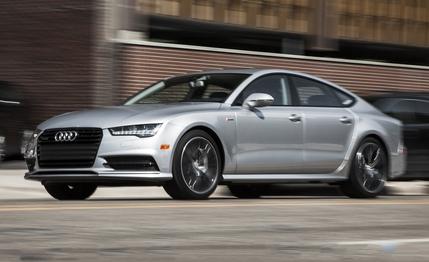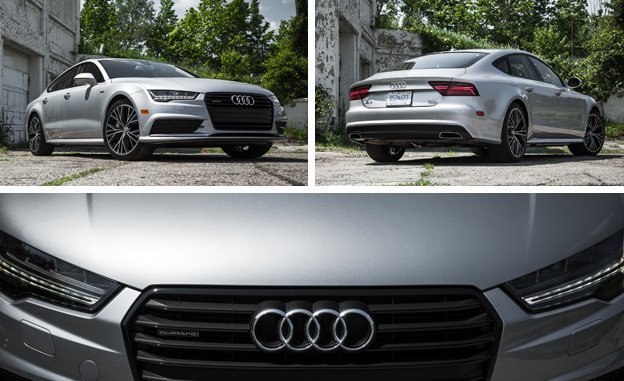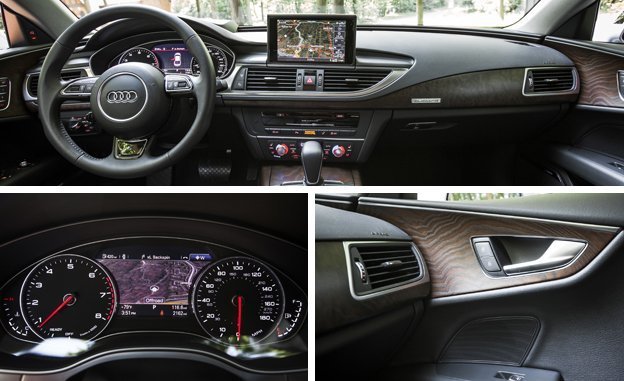 Instrumented Test
Instrumented Test
As you’d expect at its price point and available specifications, the Audi A7 delivers generous helpings of comfort and performance, making it automotive self-indulgence of a pretty high order.
But that’s not what sets it apart; there are many cars in this class that, in varying degrees, provide exactly the same. What makes the A7 special is that it’s one of those rare pieces of kinetic sculpture that makes its owner grateful for the gift of eyesight.
Audi assigns the A7 to that growing class called “four-door coupes,” which has made “coupe” a word that’s becoming almost as elastic—and one that is equally nonsensical—as “crossover.” According to Brother Webster, a coupe is “a closed, two-door automobile.” This car has four doors, and like its fraternal twin the A6, it is in actuality a sedan—albeit here with a rear hatch.
The styling element that sets apart the A7 and others of this vehicle type—the Mercedes-Benz CLS and the BMW 6-series Gran Coupe, say—is a roofline that slopes away aft of the B-pillar, culminating in a fast backlight. It’s a design element common to most contemporary coupes, thus apparently justifying the stretch to include cars with four doors.
Semantics notwithstanding, Audi’s execution of this design is the best of the bunch, and we’re pleased to see that in this 2016 freshening Ingolstadt has had the good sense to refrain from making any major changes. The grille isn’t quite so assertive as was the 2015 model’s, the LED headlights and the taillights take on more of a squint, and the exhaust outlets become rectangular. That’s pretty much it for aesthetic alterations.

Always an Audi strong suit, the interior is tastefully sumptuous, with upgrades to infotainment features and, in our Prestige-package-equipped test car, it includes a head-up display, which is very helpful in a car that masks its speed so well. Another helpful new item is standard blind-spot warning (Audi calls it Side Assist). Like other cars with swoopy rooflines, the A7’s rear-quarter visibility is a little marginal.
We mentioned speed, and there’s plenty of it on tap for 2016. Audi has mined another 23 horsepower from the output of the A7’s 3.0-liter supercharged V-6, bringing the total to 333 at 6500 rpm. Torque is unchanged at 325 lb-ft and comes on strong well down the rpm range.
The transmission, an eight-speed ZF-sourced automatic, is familiar as well, and although its shifts lack the right-now urgency of Audi’s dual-clutch automatic, response to the paddle shifters is prompt and operation in full auto mode is essentially seamless.
You’d think the addition of 23 horses to a two-ton sedan wouldn’t make much difference in its getaway stats, but you’d be wrong. Compared with the last A7 3.0 we tested, this 2016 model was almost a half-second quicker to 60 mph, at 4.7 seconds, and nearly a full second quicker to 100 (11.8 ticks). It also knocked three-tenths off its predecessor’s quarter-mile time, arriving with 2 more mph on the speedo (13.4 seconds at 105 mph). All of this despite weighing in at 4234 pounds, 56 pounds heavier than the older model.
The 2016 version is also thriftier, according to the EPA—20 mpg city and 30 highway, versus 18/28 for the 2015 car. That said, our heavy feet logged only 20 mpg during this test versus 24 before. More-judicious drivers will no doubt do better. Interior noise levels are another area of noteworthy improvement, trimming four decibels off the previous car’s figure at a steady 70 mph.
The A7 is a big car, and it feels big—but never ponderous. Responses to the helm are prompt, body roll is modest, and if the steering is lifeless at a parking-lot pace, it acquires the right level of effort and respectable accuracy as speeds increase. Typical for a big, all-wheel-drive car, when pushed hard the A7 will exhibit progressive understeer—this is not an autocross weapon—but is totally predictable in its manners, free of any real vices, and smooth even on gnarly surfaces.
Braking is powerful and fade free, with good stopping distances (166 feet from 70 mph), although we’ve seen better in other A7s. We put this down to our test car’s Continental ProContact TX (265/35-20) all-season tires. This also applies to skidpad performance; 0.84 g isn’t bad, but we’ve recorded as high as 0.91 in previous tests.

Demerits? Very few. Throttle tip-in can be a little abrupt from rest—a touch of the pedal produces languid response, a little more produces more scoot than the driver might like. And Audi’s software mavens need to tweak their ones and zeroes in the auto stop-start program, which isn’t as refined as some.
With a base price of $69,225, no one would call the 2016 A7 inexpensive. And our test car was enhanced with $6200 worth of options: the Prestige group ($2650; head-up display, Bose surround-sound audio, ventilated front seats, LED interior lighting); Black Optic package ($1500; 20-inch wheels with matte titanium finish, all-season tires); S line sport package ($1000; sport suspension, S line exterior trim); Cold Weather package ($500; heated steering wheel, heated rear seats); and silver metallic paint ($550).
For a car like ours, you’re talking $75,425, a hefty sum by any reckoning—and particularly when you could have the same or similar performance from the more conservative A6 for some $10,000 less. On the other hand, the A7 is considerably less expensive than its swoopy “four-door coupe” rival from BMW. And it possesses an eye-candy quotient that few—if any—can match.